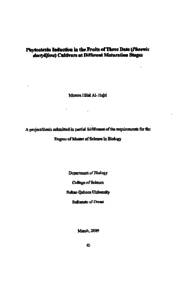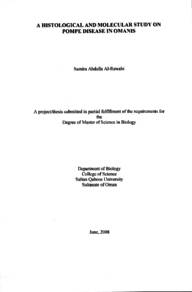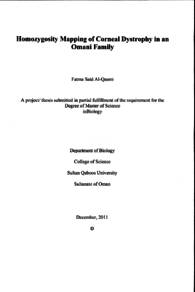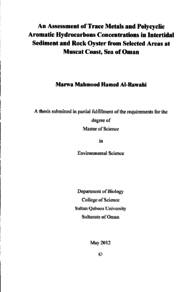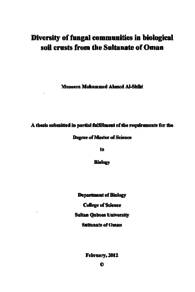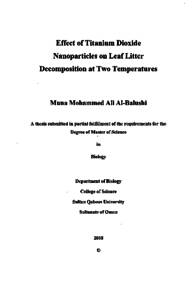Document
Phytoalexin induction in the fruits of three date (phoenix dactylifera) cultivars at different maturation stages
Publisher
Sultan Qaboos University
Gregorian
2009
Language
English
Subject
English abstract
Phytoalexin induction in the Omani date palm fruits (Phoenix dactylifera) of three cultivars; Naghal, Khalas, and Fardh at different maturation stages were carried out using biotic and abiotic elicitors, Aspergillus niger and Cladosporium herbarum were used as biotic elicitors while abiotic elicitation was done chemically by floating the fruits on a 10mM CuCl2 solution. The date palm fruits responded to the biotic and chemical elicitors by producing and accumulating new compounds that were absent in the controls.
In fruits of the Fardh variety, A. niger was the only effective phytoalexin inducer, however the Khalas fruits responded positively to both A. niger and C. herbarum although the former was the best in inducing phytoalexins. The chemical inducer CuCl2 was the most suitable stress agent for the production of phytoalexins in the Naghal fruits.
The results showed that Hababok, and Jamry are the best stages for a number of phytoalexins produced followed by the Khalal stage in their response to the biotic and chemical elicitors in all of the three varieties.
The survey for phytoalexin in date palm fruits showed that these fruits, in addition to their ability to produce phytoalexins, possess constitutive antimicrobial compounds that are active against a wide range of bacteria and fungi, In total, I have identified nine different antifungal compounds: Benzoic acid, Sinapic acid, p-Coumaric acid, Ferulic acid, Umbelliferone., Esculetin, 7 hydroxy flavan, cyinnamic acids and Vanillin.
Phytoalexins from Khalas were found to be: Ferulic acid, Cinnamic acid, Vanillin, Umbelliferone and 7-hydroxy flavan. The phytoalexins from Naghal fruits were found to be: Ferulic acid, Vanillin and 7-hydroxy flavan, while phytoalexins from Fardh was found to be Umbelliferone.
Member of
Resource URL
Arabic abstract
في هذه الدراسة تم تحفيز إنتاج مضادات الفطريات تسمى المركبات الفيتو ألكسينية) حيويا وغيرحيويا في ثلاث انواع من ثمار الرطب العماني خلال مراحل النضوج المختلفة وهي النغال، الخلاص ، الفرض تم التحفيز حيويا باستخدام فطريات من نوع اسبرجيلاس نیجر و کلادوسبوریوم هربارم في حين تم استخدام محلول كلوريد النحاس كمحفز كيميائي غير حيوي.
استجابت ثمار النخيل التحفيز بنوعيه بإنتاج مواد جديدة لم تكن حاضرة في ثمار النخيل الغير معالجة ووجد أن ثمار الفرض قد استجابت فقط للفطر أسبرجيلاس نيجر في حين أن الخلاص قد تجاوب للنوعين معا مع استجابة أكثر للفطر الأول. كما وجد أن التحفيز الكيميائي الغير حيوي هو الأمثل والأنسب لعملية إنتاج مضادات الفطريات ( الفيتو ألكسينات) في ثمار النغال.
الدراسة أظهرت أن مرحلتي الحبابوك والجمري هي أكثر المراحل النضوج استجابة التحفيز بنوعيه تليه مرحلة الخلال.
التحاليل التي أجريت للثمار أظهرت بالإضافة إلى إمكانية إنتاجها (الفيتو ألكسينات) وجود مواد طبيعية ذات طابع مضاد للكائنات الدقيقة غير منتجة بفعل التحفيز وهي نشطة ضد أنواع واسعة من البكتريا والفطريات.
إجماليا تم التعرف على تسعة أنواع من هذه المركبات: حمض الفروليك، حمض السيناميك، الفنالين، الأمبیلفرون، 7-هیدروکسي فلافان، حمض البنزويك، حمض سينابيك، حمض البيوكوماريك، إسكيولتين.
وجدت المركبات الخمس الأولى في ثمار الخلاص، وفي النغال : الفنالين، الأميفرون، 7-هیدروکسي فلافان، في حين وجد في الفرض مركب واحد فقط هو: الأمبیلفرون.
استجابت ثمار النخيل التحفيز بنوعيه بإنتاج مواد جديدة لم تكن حاضرة في ثمار النخيل الغير معالجة ووجد أن ثمار الفرض قد استجابت فقط للفطر أسبرجيلاس نيجر في حين أن الخلاص قد تجاوب للنوعين معا مع استجابة أكثر للفطر الأول. كما وجد أن التحفيز الكيميائي الغير حيوي هو الأمثل والأنسب لعملية إنتاج مضادات الفطريات ( الفيتو ألكسينات) في ثمار النغال.
الدراسة أظهرت أن مرحلتي الحبابوك والجمري هي أكثر المراحل النضوج استجابة التحفيز بنوعيه تليه مرحلة الخلال.
التحاليل التي أجريت للثمار أظهرت بالإضافة إلى إمكانية إنتاجها (الفيتو ألكسينات) وجود مواد طبيعية ذات طابع مضاد للكائنات الدقيقة غير منتجة بفعل التحفيز وهي نشطة ضد أنواع واسعة من البكتريا والفطريات.
إجماليا تم التعرف على تسعة أنواع من هذه المركبات: حمض الفروليك، حمض السيناميك، الفنالين، الأمبیلفرون، 7-هیدروکسي فلافان، حمض البنزويك، حمض سينابيك، حمض البيوكوماريك، إسكيولتين.
وجدت المركبات الخمس الأولى في ثمار الخلاص، وفي النغال : الفنالين، الأميفرون، 7-هیدروکسي فلافان، في حين وجد في الفرض مركب واحد فقط هو: الأمبیلفرون.
Category
Theses and Dissertations

